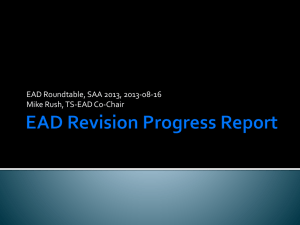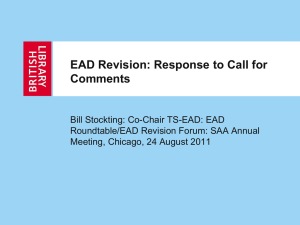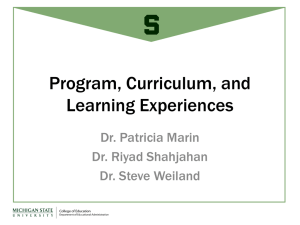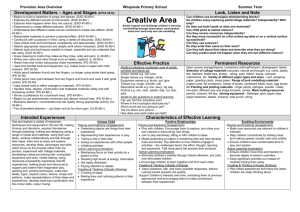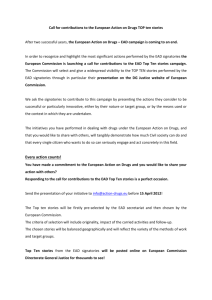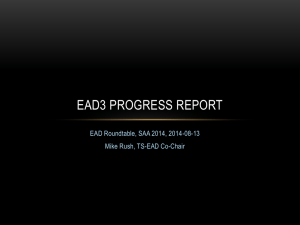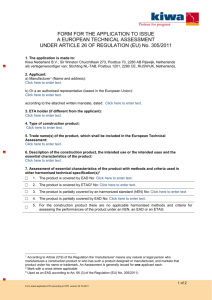Encoded Archival Description
advertisement
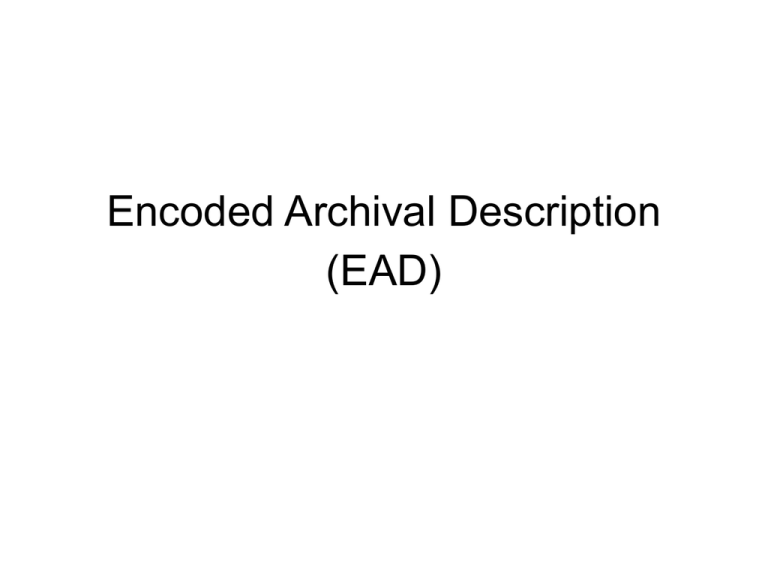
Encoded Archival Description (EAD) What is EAD? • Defines the structural elements of finding aids and their relationships • Expresses those concepts in the syntax of XML – What is XML? • Standard for electronic encoding of text. Facilitates computer manipulation of documents • Metalanguage: generalized grammar for mark up that is implemented in other more specific standards like EAD • Based on SGML ENCODED ARCHIVAL DESCRIPTION (EAD) • The standard is maintained in the Network Development and MARC Standards Office of the Library of Congress (LC) in partnership with the Society of American Archivists. • Development of the EAD DTD began with a project initiated by the University of California, Berkeley, Library in 1993. • EAD was designed to accommodate the hierarchical structure that archivists impose on large collections of unpublished material. • The inventory section of a finding aid begins by describing the major groups into which a collection has been organized. • For example, a collection might be organized at the broadest level into series such as "Correspondence," "Financial Records," "Writings," and "Clippings." Example of Hierarchical Arrangement • Each of these broad categories might be broken into smaller subseries such as "Incoming Letters" and "Outgoing Letters." • Subseries may then be divided into files ("Outgoing Letters AM"). • Here's how a broad Correspondence series, along with its narrower subseries level and still narrower file level, would be displayed as part of an EAD-encoded finding aid” • CORRESPONDENCE – Incoming Letters • A-L M-Z – Outgoing Letters • A-F G-N P-W Characteristics of Encoding Standards • Class of documents (archival inventories) • Identifiable set of common elements • Codification in a standard – MARC 21 standard – EAD DTD and Tag Library • Standards maintenance process Separating Markup and Display • Content • EAD document • Presentation • Stylesheet file • Output • Browser, Print What EAD enables • Use of finding aid content as data, not just a text file • Standardized data exchange • Data longevity and migration • Structured display, navigation, searching • Multilevel description EAD • The Analogy – EAD is to archival inventories what MARC is to catalog records • Big Concepts – International community standard compliant with ISAD(G) – Focus on content and structure rather than presentation – Reuse of data XML Concepts • Document Type Definitions/Schemas – Defines document structure • Elements – Informational units • Attributes – Modify elements • Entities – External files • Style sheets – Prescribe presentation Elements (nouns) • Have start tags and end tags – <title>Moby Dick</title> • Have formal names and tag names – Formal name = paragraph – Tag name (generic identifier) = <p> Elements (nouns) • May contain text – PCDATA (parsable character data) • <title>Moby Dick</title • May be empty – <lb></lb> (line break) – XML syntax = <lb/> (empty element syntax) Elements (nouns) • May contain other elements – Wrappers – Nesting – Example: <date> <month>September</month> <day>12</day> <year>1958</year> </date> Attributes (adjectives) • Modify the meaning of elements – <car>Honda</car> • Attributes of cars – Color – Year – Model • <car color=“green” model=“Civic” year=“1996”>Honda</car> Entities • A set of characters references as a unit – Special characters • Language keyboard • Character map: XML software • Character entity: $141; &amp – Non-text files (images, sound files) – External data files Style Sheets • Separate file • Controls presentation of data – Text format: font, size, color – Text layout: tabs, indents, line spacing, line breaks, tables • Can supply default text and images EAD 2002 Tag Library • TL Conventions • Attributes • EAD elements – Brief description of element – May contain/may occur within – List of attributes and attribute values – Encoded examples • Crosswalks EAD Design - Multilevel Description • General description of entire body of materials (biographical sketch, scope and contents, administrative information) • Description of individual series or other groupings (series or subseries descriptions) • Description of files or items (container or folder list) EAD Elements • EAD consists of about 145 elements that describe the functions of various portions of a finding aid--elements such as <title>, <scopecontent>, <bioghist>, etc. encase the portions of information that serve that function • It includes all 26 ISAD(G) elements • The fact that the tag name exists within angled brackets allows the computer, and us, to distiniguish between markup tags and the content of the document EAD Elements • Why does EAD have 145 elements vs. 26 in ISAD(G)? – EAD finding aid includes descriptive information about the computer file itself in the EAD Header – ISAD(G) is a set of core and common elements. Some elements not defined in ISAD(G) that may be necessary to describe some archival materials (e.g. bibseries) – ISAD(G) defines elements broadly; computers need more specific information to manipulate the content of a finding aid – GOOD NEWS: In most applications, only 30-40 EAD elements are used. EAD Attributes • Declaring the function of a piece of text with an element may not provide enough information about it • For example, archivists house materials in many types of containers such as boxes, folders, map drawers, etc. • The developers of EAD could have included a tag for each, but to avoid creating an unmanageable number of tags, they used a device called an attribute • Can modify generic tags like <container> by inserting an attribute and its value into the tag • <container type=“box”><container type=“folder”>, etc. EAD Attributes • <archdesc level="collection" relatedencoding="MARC"> <accessrestrict encodinganalog="506"> <head>Access</head> <p> The collection is open for research use, with the exception of the correspondence files in Series 1, Box 7, which are restricted until 2030.</p> </accessrestrict> Stylesheets • Robust markup languages define the function of a text: font, color, italics, etc. • Can create consistent presentation of presentation of all finding aids EAD Structure EAD splits the finding aid into segments, basically a metadata record that describes the content of the finding aid, followed by the content of the finding aid, which describes the collection. The structure then has these components: <ead> <eadheader> <frontmatter> <archdesc> </ead> The header creates a Dublin-core-like metadata description of the salient features of the collection (title, provenance, dates, etc.) and frontmatter describes the title-page like elements of the finding aid. <eadheader> <eadheader> <eadid> <filedesc> <titlestmt> Finding aid metadata Identification Publication <publicationstmt> <profiledesc> <revisiondesc> Creation Revision <eadheader> attributes • • • • • • • audience = “external” or “internal” encodinganalog = “MARC” langencoding =“iso639-2b” countryencoding = “iso3166-1” dateencoding = “iso8601” repositoryencoding = “iso15511” scriptencoding = “iso15924” Front Matter <frontmatter> <titlepage> <author> <date> <edition> <publisher> <sponsor> <subtitle> <titleproper> <div> </frontmatter> EAD Structure Archdesc then contains the whole finding aid, in essence describing the archival collection, using the following elements where applicable: • <did> brief descriptive identification of unit – <unitttile> title – <unitdate> inclusive and bulk dates – <physdesc> physical description; extent • <bioghist> biography/history • <scopecontent> scope and content • <controlaccess> controlled access • <accessrestrict> restrictions on access • <acqinfo> immediate source of acquisition • <dsc> description of subordinate components Components of an EAD-encoded Finding Aid • <ead> – Encloses all other elements and indicates to a computer that what follows is a document encoded using EAD • <eadheader> (required) – contains metadata about the title, author, and creation date of the finding aid, as well as information about the language in which the finding aid is written and details about its encoding • <frontmatter> (optional) – Includes subelements that allow the creation of title pages and other publication-type prefatory material such as acknowledgments and introductions • <archdesc> – contains unfolding hierarchical levels of description by first allowing a descriptive overview of the whole, followed by more detailed description of the parts, or Components <c> <Archdesc> • Wrapper element • Must have a LEVEL attribute that identifies the highest level of description represented in the finding aid, e.g., collection, record group, series, or subseries • Setting the AUDIENCE attribute to “external” makes all the text in <archdesc> viewable to all readers • If there is a MARC record for the collection, set the RELATEDENCODING attribute to “marc” • The LANGMATERIAL attribute specifies the language of the collection materials Example: <archdesc level=“collection” langmaterial=“ger eng”> The high-level <did> • The elements available within the Descriptive Identification <did> element provide basic building blocks for any level of description • <did> is available at all levels of description, although specific component elements may not be required at all levels (e.g., origination or repository data) • <did> elements include: – Repository <repository> – Origination <origination> – Title of the unit <unittitle> – Date of the unit <unitdate> – Physical Description <physdesc> – Abstract <abstract> – ID of the Unit <unitid> – Physical Location <physloc> – Language <langmaterial> Example of <did> <did> <head>Descriptive Summary</head> <unittitle label=“Title”>Wolfgang Iser Papers,<unitdate type=“inclusive”>1952-1995</unitdate></unittitle> <unitid label=“Collection number”>MS-C06</unitid> <origination label=“Creator”><persname source=lcnaf”>Iser, Wolfgang</persname></origination> <physdesc label=“Extent”><extent>2.4 linear feet (6 boxes)</extent></physdesc> <repository label=“Repository”> <corpname>University of California, Irvine. Library. Special Collections and Archives.</corpname></repository> </did> Repository <repository> name of holding institution <corpname> <subarea> <address> PCData </repository> <repository> example <repository> <corpname>Columbia University Libraries <subarea>Rare Book and Manuscript Library</subarea></corpname> </repository> Origination <origination> creator or collector <corpname> <famname> <persname> PCData </origination> <origination> example <origination>Provenance, William Fonds, 1897-1938</origination> <origination><persname encodinganalog = “100”>Provenance, William Fonds, 18971938</persname></origination> Unit Title <unittitle> title of the material being described <corpname><famname><persname> <genreform> <subject> <title> <unitdate> PCData </unittitle> Unit Date <unitdate> date(s) of the unit being described Attributes-type (inclusive or bulk) normal standard form of the date to facilitate searching (YYYYMMDD format) <unittitle> and <unitdate> examples <unittitle>William Fonds Provenance Papers, </unittitle> <unitdate type=“inclusive” normal=“1917/1937”>19171937</unitdate> Physical Description <physdesc> <dimensions> <extent> <genreform> PCData </physdesc> <physdesc> examples <physdesc>100 boxes (50 linear feet)</physdesc> <physdesc><extent>10</extent><genreform> photographs</genreform></physdesc> Identifier of the Unit <unitid> a unique identifier for the collection, series, file, item, etc. Attributes-countrycode: ISO code for the country of the repository that is the custodian of the materials repositorycode: ISO code for the repository <unitid> examples <unitid countrycode=“US” repositorycode=“NNC”>Mss 813</unitid> <unitid type=“accession number”>M4392</unitid> Language of the Material <langmaterial> <language> PCData </language> </langmaterial> <langmaterial> example <langmaterial> Correspondence in <language>French,</language> <language>German,</language>and <language>English.</language> </langmaterial> Container <container> PCData Type attribute <container type=“Box”>1</container> <container type=“Folder”>5</container> <container type=“Reel”>7-10</container> Physical Location <physloc> physical location within the repository <physloc type=“repository”>5C:SW:6.5</physloc> <physloc>Collection is in offsite storage. Requires 24-hour notice for paging.</physloc> Descriptive Identification of the Unit <archdesc> <did> <repository> <origination> <unittitle> <unitdate> <physdesc> <unitid> <abstract> <langmaterial> <materialspec> <physloc> <container> <note> <dao> and <daogrp> digital archival object <head> Biography or History • Contextual information about the creation or formation of a body of archival materials in the form of either a biographical sketch or an agency history • Information can be in the form of either narrative text or a chronology in which dates and events are paired in columnar form • Mark up only text that will be useful to users doing searches Biography or History <archdesc> <bioghist> <head> <p> <chronlist> chronology <chronitem> <date> <event> or <eventgrp> <bioghist> (recursion) <dao> e.g. picture of creator </bioghist> Example of <bioghist> <bioghist> <head>Biographical Chronology</head> <chronlist> <chronitem> <date>1926</date> <event>Born on July 22 in Marienberg (Saxony), Germany.</event> </chronitem> <chronitem> <date>1946-1946</date> <event>Student at the University of Tubingen.</event> </chronitem> … </bioghist> Scope and Content • Summarizes the range and topical coverage of the described materials, often mentioning their form and organization, and naming significant individuals, organizations, events, places, and subjects represented in the materials. • Can contain: – <organization> – <arrangement> – Access points such as <persname>, <subject>, and <genreform> Scope and Content <archdesc> <scopecontent> <head> <p> <arrangement> <scopecontent> </scopecontent> <scopecontent> example <scopecontent> <head>Collection Scope and Content Summary</head> <p>The Wolfgang Iser Papers contain material related to his publications, reading and lecture notes for courses taught throughout his career, and papers presented at conferences. The papers reflect Iser’s main interests as a professor of English literature and as a leading literary theorist. The bulk of the material dates from after his appointment in 1967 as a professor at the University of Konstanz, in Germany; some material documents his teaching at the University of California, Irvine from 1978-1995.</p> …<arrangment> <p>The collection is organized into three series: <list type=“simple”> <item>Series 1. Biographical material, 1952-1985. 0.1 linear ft.</item> <item>Series 2. Teaching and conference material, 1969-1995. 1.8 linear ft.</item> <item>Series 3. Publications, 1982-1998. 0.5 linear ft.</item></list></p> </arrangement> </scopecontent> Arrangement <archdesc> <arrangement> <head> <p> <list> <arrangement> </arrangement> <arrangement> example <arrangement> <p>The collection is arranged in three series … </p> </arrangement> <arrangement> <p>Correspondence is filed alphabetically.</p> </arrangement> Controlled Access <controlaccess> • To provide maximum access to the materials through authority-controlled searching, the Controlled Access Headings <controlaccess> wrapper element allows the use of terms analogous to those used in MARC 1XX, 6XX, and 7XX fields. • Sub-elements within <controlaccess> include <persname>, <corpname>, <genreform>, <occupation>, <famname>, <geogname>, <subject>, and <title>, which can be used along with [source] attributes specifying the controlled vocabulary being used, i.e., “lcnaf”, “aat” or “lcsh.” Controlled Access <controlaccess> authority forms of search terms <corpname> <famname> <function> <genreform> <geogname> <occupation> <persname> <subject> <title> <controlaccess> examples <controlaccess> <subject source=“lcsh” encodinganalog=“650”>Fruit trade</subject> <persname source=“lcnaf” encodinganalog=“100”>Clinton, Bill, 1946</persname> </controlaccess> <controlaccess> examples <controlaccess> <head>Index Terms</head> <p> This collection is indexed under the following headings in the online catalog of the Rodgers Library.</p> <persname encodinganalog="600">Kelly, Basham, 19141990.</persname> <persname encodinganalog="600">Warren, Robert Penn, 1905</persname> <persname encodinganalog="600">Stuart, Jesse, 1906-1984. </persname> <persname encodinganalog="600">Arnow, Harriette Louisa Simpson, 1908</persname> </controlaccess> Administrative Information: May use <descgrp> as wrapper element <archdesc> <accessrestrict> conditions governing access <userestrict> conditions governing use <custodhist> custodial history <altformavail> alternate forms of materials <originalsloc> location of originals <phystech> physical and technical specs <prefercite> preferred citation More Administrative Information <archdesc> <acqinfo> acquisitions information <accruals> <appraisal> <processinfo> processing information Example of administrative information <descgrp> <head>Administrative Information</head> <accessrestrict> <head>Access</head> <p>Collection is open for research.</p> </accessrestrict> <userestrict> <head>Publication Rights></head> <p>Property rights reside with the University of California. Literary rights are retained by the creators of the records and their heirs. For permissions to reproduce or to publish, please contact the Head of Special Collections and Archives.</p> </userestrict> </descgrp> Example of administrative information (cont) <prefercite> <p>Wolfgang Iser Papers. MS-C06. Special Collections and Archives, The UC Irvine Libraries, Irvine, California.</p> </prefercite> <acqinfo> <head>Acquisition Information</head> <p>Gift of Wolfgang Iser in 1992, 1998 and 1999. Additional accruals are expected.</p> </acqinfo> Description of the Archival Unit <archdesc> <did> descriptive identification of unit <bioghist> biography/organizational history <scopecontent> scope and contents <arrangement> physical/logical ordering <controlaccess> controlled access points <odd> other descriptive data <descgrp> description group <dsc> description of subordinate components <dsc> Subordinate Components • <dsc> description of subordinate components • <c01 level=“series”> [description of component] <did> <unittitle> <admininfo> <bioghist> <scopecontent> <controlaccess> </did> <c02 level=“subseries”> <did>... • <c03> ... • <c04> ... <c12> Which elements are required? <ead> <eadheader> <eadid> <filedesc> <titlestmt> <titleproper> <archdesc> and LEVEL attribute> <did> EAD and ISAD(G) ISAD(G) states that to be a conformant archival description a finding aid must: • Be hierarchical: That is it must be made up of a number of levels, and must follow the four rules of multi-level description • Have certain data elements EAD is specifically designed to allow the representation of ISAD(G) finding aids EAD and Hierarchy ISAD(G) levels: • Fonds • Sub-fonds • Series • Sub-series • File • Item • • • • • • • EAD levels: <ARCHDESC> <DSC><C01> <C02> <C03> <C04> <C05> ISAD(G) to EAD ISAD(G) (v.2) • 3.1.1 Reference code(s) • • • • • • • • • • 3.1.2 Title 3.1.3 Dates of creation 3.1.4 Level of description 3.1.5 Extent of the unit 3.2.1 Name of creator 3.2.2 Administrative/Biographical history 3.2.3 Custodial history 3.2.4 Immediate source of acquisition 3.3.1 Scope and content 3.3.2 Appraisal, destruction and scheduling EAD 2002 • <unitid> countrycode and repositorycode attributes • <unittitle> • <unitdate> • <archdesc> and <c> level attribute • <physdesc>, <extent> • <origination> • <bioghist> • • <custodhist> • <acqinfo> • • <scopecontent> • <appraisal> ISAD(G) to EAD • • • • • • • • • • 3.3.3 Accruals 3.3.4 System of arrangement 3.4.1 Access conditions 3.4.2 Copyright/Reproduction 3.4.3 Language of material 3.4.4 Physical characteristics 3.4.5 Finding aids 3.5.1 Location of originals 3.5.2 Existence of copies 3.5.3 Related units of description • 3.5.4 Publication note • 3.6.1 Note • • • • • • • • • • <accruals> <arrangement> <accessrestrict> <userestrict> <langmaterial> <phystech> <otherfindaid> <odd> <altformavail> <relatedmaterial> and <separatedmaterial> • <bibliography> • <odd> Advantages of EAD • • • • Created by archivists for archivists Compatible with ISAD(G) Stable, non-proprietary XML is THE international standard for data exchange • Electronic delivery • Designed to represent complex hierarchies Advantages of EAD • Multiple uses (repurposing) • Powerful XML tools for searching, retrieving, displaying and navigating • Long-term accessibility • Cross-searching: advantages of being part of larger community • EAD supports ISAD(G) element set completely, particularly multi-level description • EAD was created by archivists, for archivists Caveats • Complex suite of technologies • Requires evaluation of hardware and software options • Ongoing maintenance • Technical expertise • Training • Commitment of resources • Changes to workflow methodologies? Implementing EAD: Creating Encoded Finding Aids • Adopt an encoding protocol – Ensure consistent markup – Enable interoperability – Facilitate display – Consortial protocols – RLG Best Practices Guidelines for EAD Implementing EAD: Creating Encoded Finding Aids • Select, install and configure authoring software – EAD Cookbook – Templates • Encode finding aids – New documents – Covert existing finding aids • Rekey text • Cut-and-paste into an editor • Outsource markup – MARC 21 Implementing EAD: Enable Resource Discovery • Full-text databases • Web search engines (Google, Yahoo) • Links from MARC records – Field 856 Electronic location and access – Field 555 Finding aid availability note • Subject-oriented web pages Implementing EAD: Deliver Finding Aids on the Web • Adapt or adopt existing stylesheets or create new ones • Transform finding aids into HTML • Mount finding aids on web server Where to get files and help • http://www.loc.gov/ead/ – Official EAD website with online Tag Library and Application Guidelines • http://www.archivists.org/saagroups/ead/ – SAA EAD Roundtable Help Pages—EAD Cookbook templates in XMetaL, NoteTab and <oXygen/>, and stylesheets • Library of Congress EAD listserv – ead@loc.gov – listserv@loc.gov (subscribe ead your name)
